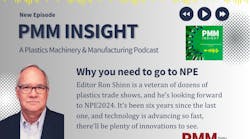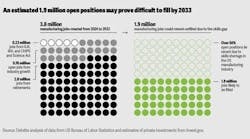By Ron Shinn
I decided some time ago not to get excited about reshoring. Before the companies that moved manufacturing to China ever considered coming back to North America, they would first look at other low-cost countries in Asia and Africa. If reshoring ever happened, it would be a slow, evolutionary process that would take years before plastics processors could see benefits.
Our recent survey of readers shows that you definitely think I am wrong. The survey included a question asking, “What is your greatest opportunity today?” More people wrote “reshoring” than any other response.
Is it now going to happen at a faster rate?
The media have covered reshoring extensively since the COVID-19 pandemic started. The trigger came when everyone realized that much of our critical personal protective equipment and medical equipment is made in China and the supply chain could not keep up with our immediate demand.
Harry Moser, founder and president of the nonprofit Reshoring Initiative, said in a recent article that medical supplies accounted for roughly $53 billion worth of U.S. imports last year. Reshoring production for half of those supplies could generate 302,000 jobs and add $534 billion to the GDP.
Moser predicts that makers of non-medical plastic parts also will benefit from reshoring.
To help correct the PPE shortfall, the Pentagon in late June signed an agreement with the U.S. International Development Finance Corp. (DFC) to provide loans from a $100 million pool for creating, expanding or restoring domestic manufacturing of products in response to the COVID-19 crisis.
The DFC loans will likely benefit plastics processing companies when their customers buy more U.S.-made medical components. It is probably a great time to be in the medical parts manufacturing business.
North American plastics manufacturing and materials companies dramatically ramped up production of PPE and medical equipment in immediate response to the pandemic. In some cases, companies spent money they had no chance of recouping to produce medical equipment because it was the responsible thing to do.
Processing companies that switched gears to manufacture face shields, masks, respirators and other COVID-19 equipment alongside their regular production projects now might find a profit in making PPE on an ongoing basis.
There might also be new opportunities for medical products packaging manufactured here.
Processors need to remember one key point about manufacturing costs when talking to a customer that is on the fence about reshoring a part. Many companies think manufacturing costs in the U.S. are too high to bring work back from Asia. Moser said his research shows that the Ex Works (EXW) price — the price of a product leaving the dock of the company that makes it — indicates that only about 8 percent of work makes sense to reshore to the U.S.
But when you consider all the costs — EXW price plus duty-free packaging, shipping, the cost of maintaining inventory, the value of a Made in USA label, and other factors — it goes from 8 percent to 32 percent. If the product also happens to be subject to a 15 percent tariff, then it goes to 46 percent.
Moser recognizes the reality that our investments in a skilled workforce, productivity and automation are just not enough to make up for our higher labor costs. Since we are not price -competitive, it is critical to look at total costs.
Manufacturing in North America reduces the vulnerabilities associated with a supply chain that reaches to China. The COVID-19 pandemic will cause some medical and non-medical OEMs to reassess the risk they face buying from China compared with buying plastic parts closer to home where they have more control.
Another interesting finding from our reader survey: Automation and robotics ranked No. 1 among technologies processors are considering for future deployment. These are necessary components in bringing down total production cost.
It is a complex process for an OEM to move manufacturing of a part or component from China to North America, but COVID-19 will likely speed up the return of some manufacturing, and plastics processors, as well as machinery manufacturers, will surely benefit.
You can move me from the skeptical column to the mostly convinced column. There are plenty of forces pushing and pulling the future of North American manufacturing — including politics — but the luster has certainly been taken off globalization.
It will be an interesting time ahead, but one that should eventually be better for the plastics industry.
Ron Shinn, editor






